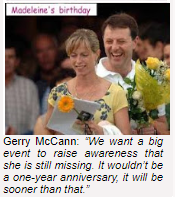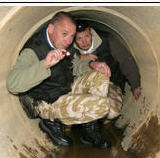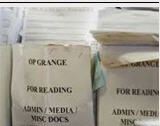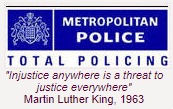Drawing Madeleine McCann: Forensic artist's 'huge responsibility'
Page 1 of 1 • Share

Sceptic- Posts : 198
Activity : 311
Likes received : 35
Join date : 2013-09-28
 Re: Drawing Madeleine McCann: Forensic artist's 'huge responsibility'
Re: Drawing Madeleine McCann: Forensic artist's 'huge responsibility'
From staring at photographs of dead bodies to imagining how Madeleine McCann may have aged. Who are the artists used by police to help with their investigations?
When a man's naked body washed up on a Cornish beach in February, police had few clues to help them. The man had suffered multiple injuries, a pair of earphones had been stuffed in his mouth and he was wearing only a pair of socks and one shoe.
Continue reading the main story
His identity remained a mystery for days, until an artist's impression of his face was published. Within four hours it had led to the man being identified as 64-year-old Alan Jeal.
Forensic artist Teri Blythe, who created Mr Jeal's image, said success of this kind was the "ultimate aim" for people in her profession.
Mr Jeal's body has since been released to the family and no-one has been arrested in connection with his death.
"Although [it is] terrible news for the families involved, when a body is identified it helps them grieve and eventually move on," Ms Blythe said.
Police do not just turn to forensic artists to create images of dead people. They are also employed in missing persons inquiries, most famously perhaps in the case of Madeleine McCann.
The photographs of her as a three-year-old - her age when she vanished from a Portuguese holiday apartment in May 2007 - are instantly recognisable to many.
However, they were of limited use in trying to trace a girl whose appearance would certainly have changed in the intervening years.
 Teri Blythe said the age progression of Madeleine McCann was her most high profile case
Teri Blythe said the age progression of Madeleine McCann was her most high profile case
"It's always a huge responsibility for any case to not only create the best image but to also do so to the satisfaction of the parents and family who ultimately know that missing person so well," said Ms Blythe, whose skills were called upon by the Metropolitan Police in 2012.
"The high profile nature of Madeleine's case obviously added to the pressure.
"But once I and the family were confident with the aged image, we knew it would get substantial publicity and hopefully therefore lead to more information about her disappearance."
The image was part of an appeal which, along with others since, has resulted in a "high number of calls" to the investigation team, the Met Police said.
Ms Blythe said she used numerous reference photographs of family members at all ages.
She also used other photographs of children who were a similar age to Madeleine to help her decide the hair style and colour and clothing for the image.
 Sharon McDonagh said she finds it "very emotional" when a body is identified as a result of her artwork
Sharon McDonagh said she finds it "very emotional" when a body is identified as a result of her artwork
She said the McCann family also provided information on which family members she resembled most and how certain facial features were likely to develop.
Ms Blythe said most of her work was through photo manipulation on a computer, but she has also produced sketches and 3D clay models for reconstructions.
While the end result is inevitably partly guesswork, every effort is made to ensure the guesswork is as educated as possible.
Ms Blythe said she always requested photographs of the individual and - if appropriate - the scene where their body was found. Any additional description of the person's facial features and colouring are sought.
When the unidentified person has died, Ms Blythe asks for details of the manner and suspected time of death, in order to assess how much has changed as a result of decomposition.
 Twenty drawings of people found dead on Britain's rail network
Twenty drawings of people found dead on Britain's rail network
She said she often "sanitises the image" - for example, removing blemishes or injuries to the face, producing a more consistent skin tone and colour, opening their eyes, tidying the hair and adding clothes.
"The techniques vary a lot depending on how badly damaged the body may be but it is also important to remember to maintain their unique likeness," she added.
Ms Blythe, who has an academic background in anatomy and forensic anthropology, said unidentified cases were the most difficult because, due to their very nature, there were no family or original photographs of the individual to use as reference.
Continue reading the main story
"The extent of damage or decomposition will dictate if a post mortem image enhancement - photographs taken of the deceased and then edited - is possible.
"Techniques vary, but can include copying other sections of the face for skin tone, or sometimes using reference photographs of similar looking people to copy hair, clothes and even eye shape or parts of other facial features.
"It is often considered better to show the images in black and white as it removes any potential for misleading viewers.
"In some cases an image enhancement is not possible and a facial reconstruction using the skull may be considered instead."
One such case was the investigation into unclaimed bodies found on the UK's rail network. In 2010, the artist's impressions of 20 faces were released, some of people whose bodies were found as far back as the 1970s.
Forensic artist Sharon McDonagh said it was her "favourite and most challenging job" - but also, at times, emotionally draining.
"It is gruesome, you sit and look at someone's face for many hours and if half the head and eyes are missing it is quite horrific.
"You'd be heartless and weird if the job didn't affect you. You often wonder how they've got to that stage, how the family is coping, what kind of life they had and am I doing that person justice?"
Ms McDonagh said she had always had a "fascination with the dark side of art" but had stopped watching horror films since becoming a forensic artist because they were "too close to reality".
While the professional satisfaction of helping to identify a body can be very rewarding, the darker side of the job can be hard to get away from.
"There are a couple cases which do stick in your mind forever and they do haunt you forever.
"I do think about a few cases from years ago, especially around Christmas time when they killed themselves.
"You do think about how sad they were and you think about their families. It's quite an emotional job."
When a man's naked body washed up on a Cornish beach in February, police had few clues to help them. The man had suffered multiple injuries, a pair of earphones had been stuffed in his mouth and he was wearing only a pair of socks and one shoe.
Continue reading the main story
“Start Quote
Sharon McDonaghForensic artistYou do think about how sad they were and you think about their families. It's quite an emotional job”
His identity remained a mystery for days, until an artist's impression of his face was published. Within four hours it had led to the man being identified as 64-year-old Alan Jeal.
Forensic artist Teri Blythe, who created Mr Jeal's image, said success of this kind was the "ultimate aim" for people in her profession.
Mr Jeal's body has since been released to the family and no-one has been arrested in connection with his death.
"Although [it is] terrible news for the families involved, when a body is identified it helps them grieve and eventually move on," Ms Blythe said.
Police do not just turn to forensic artists to create images of dead people. They are also employed in missing persons inquiries, most famously perhaps in the case of Madeleine McCann.
The photographs of her as a three-year-old - her age when she vanished from a Portuguese holiday apartment in May 2007 - are instantly recognisable to many.
However, they were of limited use in trying to trace a girl whose appearance would certainly have changed in the intervening years.
 Teri Blythe said the age progression of Madeleine McCann was her most high profile case
Teri Blythe said the age progression of Madeleine McCann was her most high profile case"It's always a huge responsibility for any case to not only create the best image but to also do so to the satisfaction of the parents and family who ultimately know that missing person so well," said Ms Blythe, whose skills were called upon by the Metropolitan Police in 2012.
"The high profile nature of Madeleine's case obviously added to the pressure.
"But once I and the family were confident with the aged image, we knew it would get substantial publicity and hopefully therefore lead to more information about her disappearance."
The image was part of an appeal which, along with others since, has resulted in a "high number of calls" to the investigation team, the Met Police said.
Ms Blythe said she used numerous reference photographs of family members at all ages.
She also used other photographs of children who were a similar age to Madeleine to help her decide the hair style and colour and clothing for the image.
 Sharon McDonagh said she finds it "very emotional" when a body is identified as a result of her artwork
Sharon McDonagh said she finds it "very emotional" when a body is identified as a result of her artworkShe said the McCann family also provided information on which family members she resembled most and how certain facial features were likely to develop.
Ms Blythe said most of her work was through photo manipulation on a computer, but she has also produced sketches and 3D clay models for reconstructions.
While the end result is inevitably partly guesswork, every effort is made to ensure the guesswork is as educated as possible.
Ms Blythe said she always requested photographs of the individual and - if appropriate - the scene where their body was found. Any additional description of the person's facial features and colouring are sought.
When the unidentified person has died, Ms Blythe asks for details of the manner and suspected time of death, in order to assess how much has changed as a result of decomposition.
 Twenty drawings of people found dead on Britain's rail network
Twenty drawings of people found dead on Britain's rail networkShe said she often "sanitises the image" - for example, removing blemishes or injuries to the face, producing a more consistent skin tone and colour, opening their eyes, tidying the hair and adding clothes.
"The techniques vary a lot depending on how badly damaged the body may be but it is also important to remember to maintain their unique likeness," she added.
Ms Blythe, who has an academic background in anatomy and forensic anthropology, said unidentified cases were the most difficult because, due to their very nature, there were no family or original photographs of the individual to use as reference.
Continue reading the main story
“Start Quote
Sharon McDonaghIt is gruesome, you sit and look at someone's face for many hours”
"The extent of damage or decomposition will dictate if a post mortem image enhancement - photographs taken of the deceased and then edited - is possible.
"Techniques vary, but can include copying other sections of the face for skin tone, or sometimes using reference photographs of similar looking people to copy hair, clothes and even eye shape or parts of other facial features.
"It is often considered better to show the images in black and white as it removes any potential for misleading viewers.
"In some cases an image enhancement is not possible and a facial reconstruction using the skull may be considered instead."
One such case was the investigation into unclaimed bodies found on the UK's rail network. In 2010, the artist's impressions of 20 faces were released, some of people whose bodies were found as far back as the 1970s.
Forensic artist Sharon McDonagh said it was her "favourite and most challenging job" - but also, at times, emotionally draining.
"It is gruesome, you sit and look at someone's face for many hours and if half the head and eyes are missing it is quite horrific.
"You'd be heartless and weird if the job didn't affect you. You often wonder how they've got to that stage, how the family is coping, what kind of life they had and am I doing that person justice?"
Ms McDonagh said she had always had a "fascination with the dark side of art" but had stopped watching horror films since becoming a forensic artist because they were "too close to reality".
While the professional satisfaction of helping to identify a body can be very rewarding, the darker side of the job can be hard to get away from.
"There are a couple cases which do stick in your mind forever and they do haunt you forever.
"I do think about a few cases from years ago, especially around Christmas time when they killed themselves.
"You do think about how sad they were and you think about their families. It's quite an emotional job."
____________________
Goncalo Amaral: "Then there's the window we found Kate's finger prints.
She said she had never touched that window and the cleaning lady assured that she had cleaned it on the previous day....it doesn't add up"

NickE- Posts : 1405
Activity : 2152
Likes received : 499
Join date : 2013-10-27
Age : 49
 Similar topics
Similar topics» 11 Dec 2009 The McCanns v Goncalo Amaral - Part 2 (YouTube)
» No more forensic work on Madeleine McCann case say British police
» Three university forensic psychologists say > 'Anti-McCann Trolls Cannot be Cured'
» Truth will out: Forensic Scientist Angela Gallop would like to take on Madeleine McCann's cold case
» Still running... away with it
» No more forensic work on Madeleine McCann case say British police
» Three university forensic psychologists say > 'Anti-McCann Trolls Cannot be Cured'
» Truth will out: Forensic Scientist Angela Gallop would like to take on Madeleine McCann's cold case
» Still running... away with it
Page 1 of 1
Permissions in this forum:
You cannot reply to topics in this forum





































